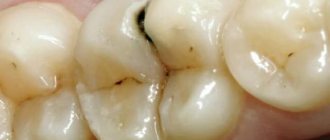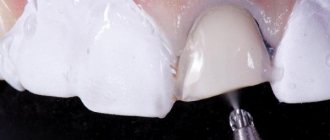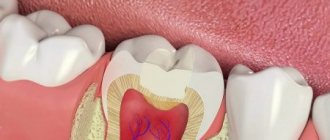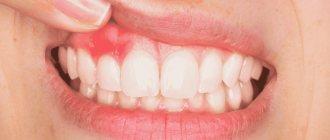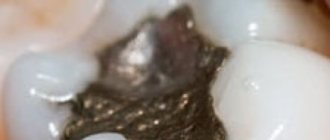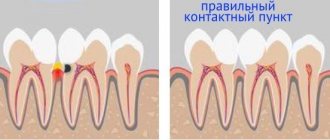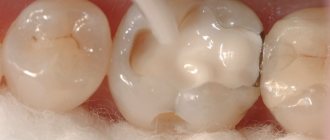Date of publication: 20-11-2018 Date of update: 19-03-2021
Author of the article: Shamray Olesya Vladimirovna Dentist
Patients make a serious mistake when choosing tooth extraction or replacement with a denture instead of treatment. Since the load and responsibilities of each tooth are clearly adjusted and distributed by nature, dentists always recommend treatment. The most common treatment method in dental practice is the installation of a filling to restore the aesthetics and, most importantly, the chewing functions of the teeth.
The function of chewing food, as well as the main load, is borne by the chewing teeth: molars and premolars.
The greatest load during chewing food falls on the large and small chewing teeth. They have more substantial roots and a wide surface, which is called occlusal or occlusal. The safety of the chewing part of the tooth determines the complete consumption of food, its correct grinding before entering the stomach, as well as the distribution of the load on the remaining teeth. Therefore, when restoring them, it is important that the filling is anatomically correct: it has irregularities, tubercles and higher edges. Only such a filling can fully participate in the chewing process and perform the functions of a healthy tooth. The material must also meet the general requirements:
- Fit tightly. This will help protect the tooth from infection and prevent secondary caries from developing. Further tooth decay will also be stopped.
- Have high strength and indestructibility by saliva. The filling must withstand constant mechanical stress during chewing, be subject to little wear and not be destroyed by acids in saliva. Of course, any fillings will require replacement over time, but the right ones will last for several years.
- Have a neutral composition. Often the nerve is not removed before filling so that the tooth remains alive longer. The filling should not release any compounds that affect nerve endings.
It is better to leave the choice of material to the dentist; it will be based not only on your financial capabilities, but also on the feasibility of using the material, its service life and the individual characteristics of the dentition.
After filling the chewing teeth, it is worth protecting them from strong mechanical stress.
What materials are used for such filling?
Let's consider all the options for filling materials that are used in Clarimed dentistry. They have proven to be the best in terms of price-quality ratio and help solve almost any problem with chewing teeth.
Glass ionomer cement (GIC). This is a modern cement material that is often used to install permanent fillings on the chewing surface. It hardens well in a humid environment, so it is also used to treat the most problematic types of caries, for example, those below the gum level. The material creates intermolecular bonds with enamel and dentin, therefore it holds well and does not require additional sites for strengthening. During the polymerization process, the cement material practically does not shrink, releases fluoride ions into the tooth tissue and adheres perfectly to the edge of enamel and dentin due to thermal expansion.
Make an appointment
Light-curing composite "Filtek". A light-curing nanocomposite material that has received medals in various dental competitions at the international level for several years in a row. It lends itself well to modeling, is aesthetic, elastic and very durable after hardening. Suitable for any carious cavities, retains its properties for a long time and is minimally susceptible to abrasion.
Liquid-flowing light-curing composite FLOW. Ideal for filling small carious cavities on chewing teeth. The material is aesthetic, well modeled, and durable.
Liquid-flowing light-curing composite Estelite. The highest award in the field of dental restoration, a kind of dental Oscar, according to the popular American magazine The Dental Advisor, was awarded to this Japanese filling material from 2010 to 2022.
Estelite is suitable for all types of carious cavities, gives minimal shrinkage when cured and has 20 shades that will completely restore the aesthetics of any tooth. This is the most wear-resistant material presented, it has minimal abrasion, and it is possible to restore both front and side teeth; cutting and chewing surfaces. The Japanese composition releases fluoride ions, therefore reducing the risk of recurrent caries. In addition, the composite is characterized by deep adhesion to dentin, resulting in a monolithic structure without a marginal gap.
If the filling is placed correctly on the chewing surface, then it is practically indistinguishable from a real tooth.
Dental fillings: domestic materials conquer the market
February 9 is International Dentist Day. Everyone is familiar with this doctor, because teeth mean beauty, well-being, and the opportunity to enjoy food. Most often, we go to the dentist to install a filling. Today, both the choice of materials for fillings and the list of trustworthy manufacturers, including domestic ones, are very extensive. We tell you how to navigate what the doctor offers and why you can trust Russian materials.
What are fillings needed for?
A filling in dentistry is a special material that is used to fill a cavity in a tooth formed as a result of damage - mechanical or caused by caries - in order to prevent further tooth destruction. According to WHO estimates, dental caries affects 60-90% of school-age children and almost 100% of adults worldwide. Based on their service life, fillings can be divided into temporary and permanent.
Temporary fillings are installed in the following cases: · to isolate medication left in the tooth; · if an inlay is required to be made in a dental laboratory (a temporary filling is placed during production); · if necessary, wait for the sealant installed in the root canals to harden; · if the doctor does not have enough time during one appointment to complete the treatment.
Permanent fillings are classified according to materials. “The choice of a suitable filling is based not only on the doctor’s recommendation and clinical picture, but also on the wishes of the patient and his financial capabilities. The price depends on the material from which the filling will be made. Different filling materials have their own characteristics of installation and operation,” says Alexander Novichkov, dental surgeon, implantologist, periodontist.
Until the mid-20th century, amalgams (compounds of metals with mercury), as well as cements, were used for fillings. With the development of science, acrylic (polymer) and composite (multicomponent) compositions began to be used.
What kind of fillings are there and which ones are produced in Russia?
There are 4 main types of fillings, and all of them, including innovative ones, are produced not only abroad, but also in our country.
1. Metal fillings The material for them is made of silver, copper, and other metals (tin, zinc, silicon, etc.), as well as mercury, which ensures plasticity and hardening. The advantages include: · service life up to 25 years; · bacteriostatic properties of silver; · strength. However, there are significantly more disadvantages: · toxicity of mercury; · color contrasting with enamel; · staining of adjacent tooth tissues; · high thermal conductivity, which provokes pain when eating hot or cold food; · taste of metal in the mouth.
Today, most specialists have abandoned metal fillings. In a number of countries their installation is prohibited due to toxicity.
2. Cements The most common material in dentistry. It is made from a powder mixture and liquid acid concentrate. Cements are divided into subgroups depending on their composition. Silicates: · consist of silicon; · have high strength, but low adhesion to enamel tissues; · complete hardening occurs slowly (up to 28 days); · requires the installation of a gasket that does not allow direct contact of the silicate with the pulp (the connective tissue that fills the tooth cavity). Phosphates: · zinc-based cements; · according to the main indicators, they are somewhat better than silicates, but inferior in aesthetic terms, therefore they are used only on the back teeth; · harden within a few hours; · often used in children, as they are easy to use and have bactericidal properties. Glass ionomers: · consist of crushed quartz, aluminum phosphate, aluminum oxide, barium salt and calcium fluoride; · resistant to acidic environments, which increases durability; · safe for pulp; Due to fluoride, they have a remineralizing effect; · can be installed on the front teeth; · widely used by Russian doctors.
The average service life of cement fillings is about five years, but with proper care and lifestyle, this period can be much longer.
3. Plastic fillings
A relatively cheap material consisting of polymers, which, however, is losing popularity. Positive properties include: · rapid hardening; · stability and strength; · ease of installation. But there are also negative aspects: · gradual decrease in volume and deformation; · tendency to stain, which is why such a filling is not placed on the front teeth; · service life – no more than five years.
4. Composite fillings This is a modern class of materials that has more advanced qualities. Self-curing composite fillings have good mechanical properties, harden chemically and are second only to light-curing composites in strength. Dental composites are a mixture of several components, that is, polymer multiphase compositions. Their range is constantly updated, and production technologies are improved. Light-polymer composite fillings, or “photofills,” are today considered one of the best in terms of durability, strength and aesthetic qualities: · the composition quickly hardens under the influence of a special lamp; · the material allows you to recreate the relief and shape, which means they are suitable for restoring even severely damaged teeth; · it is possible to choose an individual shade, therefore it is preferable for front teeth; · the possibility that the composite filling will fly out is practically eliminated; · the material is resistant to temperature changes.
For each case, a different composition of the composite mixture is chosen, which allows you to give the filling the best quality.
5. Other types of fillings Today there are also combined fillings, consisting of two or more materials. It is worth noting the so-called tabs. These are microprostheses, something between a crown and a filling. They are more expensive than regular fillings and require manufacturing in a dental laboratory. More affordable options are made from available dental materials (plastic, composite, and others), more expensive ones are made from ceramics.
Domestic manufacturers
Until recently, it was believed that the most advanced and modern materials for dentistry were produced only abroad. However, today there are products from domestic manufacturers on the market.
- TechnoDent is a Russian manufacturing company located in Belgorod. Engaged in the production of modern high-quality dental materials, including filling materials. Innovative technologies are used in production, as well as high-quality raw materials, including Russian ones. All materials have both Russian and international certificates. Imported to 55 countries around the world.
- “VladMiVa ” is a modern innovative enterprise, which has created 12 patents for inventions and registered 75 trademarks. The brand is well known to dentists in Russia. Composite materials for fillings are especially in demand. In addition, products are supplied to more than 40 countries around the world.
- StomaDent occupies one of the leading positions among domestic manufacturers of dental materials. Produces a wide range of composite filling materials, as well as glass ionomer cements.
“In clinical practice, many dentists use domestically produced filling materials. They are distinguished by affordable prices, high quality and ease of use. At the same time, the range of products offered is constantly growing, advanced composite compositions are appearing, including light-curing ones, which can be safely offered to patients,” emphasizes doctor Alexander Novichkov. Today in Russia, materials based on nanotechnology are being developed that can stimulate the regeneration of dentin stem cells and in the future may become the main one for the “eternal filling”.
Warranties and service life
When you come to the dental clinic, you sign an agreement for the provision of dental services. From this moment you are bound by agreements. Guarantees are divided into mandatory and predictable, that is, depending on the circumstances of the treatment and the conditions that the patient will need to comply with to maintain the results. You can discuss these conditions with your doctor.
Most often, for fillings, the dentist determines the service life of the filling, provided that the person follows the recommendations. The period of alteration and re-treatment is also stipulated if deficiencies are discovered through no fault of the patient. The service life of a filling largely depends not only on the selected material and proper installation, but also on the characteristics of the body, the general condition of the teeth and hygiene.
A good result is the joint work of the doctor and the patient. Don't be afraid to ask your dentist questions and discuss treatment. It will help you learn more about advanced domestic materials and make the right choice.
Text: Irina Gracheva
Post Views: 1,570
What material is better for fillings on the chewing surface?
Most likely, the dentist will offer you a choice of several materials that differ not only in their features, durability, but also in price. Choose the most expensive option available to you; it will last longer and look better.
The most expensive fillings in the world are installed in the UK. One trip to the dentist and an ordinary cement filling, which in Russia can be placed under a compulsory medical insurance policy, will cost a couple of hundred dollars.
At the Clarimed clinic you can fill a tooth for 1,155 rubles (CIS). The consultation is free, as are any questions about fillings, treatment plans, prices, durability, or anything else that worries you before the procedure. Call us, we work around the clock.
Conventional chemical
The main difference between a simple (chemical) filling and a light filling is how they harden. A regular filling becomes hard due to a chemical reaction that occurs when different types of filling material are mixed. The result is a consistency with the required density and elasticity.
Dentists typically use two types of conventional chemical fillings:
- Composite - it contains several different chemical ingredients, which, when hardened, can differ significantly from the natural color of tooth enamel. The material hardens evenly, but does not last long - usually about 2 years.
- Glass ionomer - contains a special liquid and powder, which are mixed in the required proportion.
The composition hardens due to an acid reaction. Dentists can add additional components to this mixture as needed. Attention! Glass ionomer filling is good because it has the ability to release fluoride, which serves as a preventive measure against the re-development of caries.
What is a compulsory medical insurance policy and what does it give?
Private dentistry services are quite expensive. Many patients cannot afford such expensive treatment. As a result, a visit to the doctor is constantly postponed until it becomes possible to allocate the necessary amount from the personal or family budget. Meanwhile, the disease progresses, leading to even more complex and serious complications. There is a rational solution to this problem - a compulsory health insurance policy allows its owner to receive dental care completely free of charge. It is enough to register at the nearest municipal clinic and receive the appropriate document.
Dentistry under a compulsory insurance policy: which procedures can be completed for free, and which you will have to pay for separately
Eights or wisdom teeth are removed free of charge, of course, upon presentation of the policy. But it must be taken into account that the extraction of retinated elements itself is a complex procedure. In most cases, stronger anesthesia or additional sedation is required, and these are paid services. Unfortunately, simple anesthetics may not work, so it is better to consult your doctor about this.
The usual way to get help from a dentist for free was and remains a visit to a state or municipal dental clinic. Usually, such institutions exist in every district of the city or town.
Where and how can you treat your teeth for free?
I have been treating a tooth in St. Petersburg. One tooth with two canals for three weeks now. Free with arsenic. It seems like they are making such inconveniences on purpose. For me to give up and go to a paid clinic.
Basic conditions
here in Nakhodka. You also have to wait in line for shit. Five coupons will be thrown away. I treated 2 front teeth. The canals were poorly treated. inflammation began. They unsealed it and put the paste in there. wait 2 weeks. but everything is free according to the policy. caries was told to go to a paid one. increase in fee. Before this, the front tooth was torn from above. I don’t know what they injected. do not speak. most likely Novacaine. the old fashioned way. So I thought I would die there. such pain. It's like they're digging into their brains. the whole clinic came running. I felt really bad. Then the doctor offered two paid injections for 500 rubles each. gosh . The doctor also sells pins. but they don’t exist. and it is not known when they will be. mayhem. free medicine. wouldn't be funny.
25 Apr 2022 uristgd 167
Share this post
- Related Posts
- From what point should a property deduction be applied if the employee provided it in the middle of the year?
- Northern Railway travel for labor veterans of the Yaroslavl region in 2022
- A person who signs a will instead of the testator due to his physical disabilities
- Which 1s program do budget organizations work with in 2021?
The dental clinic offers to install a paid filling
treatment of root canals of teeth: treatment of root canals using NITI rotating machine instruments, filling of root canals using thermoplastic gutta-percha and imported pastes, removal of foreign bodies from root canals;
prevention of dental diseases: preventive cleaning, removal of dental plaque using an ultrasonic device, removal of age spots, plaque, coating with imported fluoride-containing preparations, deep fluoridation of teeth, teeth whitening;
Rules for caring for fillings
Despite the fact that many fillings can theoretically last for years, it is recommended to change the materials every 10-12 years. It is recommended to visit a doctor once every six months for hygiene measures. You should also make an appointment with a doctor if:
- short-term pain in the treated area;
- detection of cracks;
- presence of a chip in the filling material.
The dentist can easily replace a bad filling with a new one.
If there is a large amount of restoration material in the cavity, you can ask the specialist to prescribe a gel with a high fluoride content. Its regular application will help strengthen the hard surface and prevent caries from forming again. Filled teeth may also be coated with fluoride varnish during the examination.
At home, it is recommended to use mouth rinses. With their help, you can significantly reduce the number of microbes that cause caries.
Summarizing the above, I would like to note that filling is a serious procedure. To prevent dental treatment under anesthesia from ending with repeated fillings and a double waste of time and money, you should seek help only from reliable, experienced specialists.
What you should (not) pay for at the doctor: 8 non-obvious situations
It is legal? No. “Light-curing fillings have always been a stumbling block in dentistry. They are considered the strongest and most stable and were often imposed on patients as paid services, explains Alexey Starchenko. “However, from January 1, 2022, light-curing fillings are included in the State Guarantee Program and must be installed free of charge to citizens.” Only in some situations, for medical reasons, may it be necessary to install a different, non-light-curing type of filling - then this must be justified and recorded in the card.
It is legal? No. The deadlines for the provision of medical services are clearly stated in the SGBP. Diagnostic instrumental studies (X-ray, mammography, ultrasound) and laboratory tests must be carried out a maximum of 14 calendar days from the date of appointment. You can wait no more than 30 calendar days for CT and MRI.
Suppose you want to see a pulmonologist (oncologist, endocrinologist, epileptologist or other specialist), but the therapist does not give a referral because he sees no reason. Essentially, this means that you will have to pay for a consultation with a specialized doctor.
A trip to the local clinic is not the most entertaining activity in the world anyway. And if you suddenly ask for money for a medical service that you expected to receive for free, your mood completely deteriorates. To pay or not? Let's look at the most typical situations.
“If you are sure that your attending physician is wrong with the diagnosis and you really need the advice of a specialized specialist, you can write a statement of disagreement with the actions of the doctor and with the diagnosis he made addressed to the head of the clinic or to the medical commission. The period for consideration of the application is 30 days,” says Natalya Ostapenko.
About paid fillings, policies and quality of treatment
“I came with a compulsory medical insurance policy to see a dentist. The doctor performed certain manipulations on me and asked: “Which filling should I get - a simple one or a good one?” At the same time, she noticed that I had to pay for a good filling. Tell me, what is the difference between a good filling and a simple one? And was the money taken from me legally?”
- We can, and we will help. We are often contacted by residents of different areas of the region who cannot urgently undergo some kind of examination. This could be an ultrasound, biopsy, computed tomography. We immediately contact the medical organization and check whether the patient has been placed on the waiting list for two or three months in advance. If you have heart pain and an ultrasound needs to be done now to establish a diagnosis and prescribe the correct treatment, then the doctor is obliged to organize an extraordinary examination. When the examination is carried out as planned, you can wait. The decision must be made by the doctor who is observing you. If, for health reasons, you cannot wait three months for an ultrasound scan, and the clinic does not cooperate, then contact the insurance company.
— If your problem remains relevant today, please come to the insurance company, write a statement, and we will sort it out. If you are wrongfully denied surgical intervention, then we will assist in organizing surgical treatment for your spouse. Our address: Blagoveshchensk, st. Krasnoarmeyskaya, 110.
JSC MSK Dalmedstrakh ranks first among insurance companies in the Amur region in terms of territorial coverage - its representatives work in all cities and districts of the region. The company has effective measures to protect the rights of insured citizens and resolve difficult situations that arise in medical institutions.
“I heard that we will soon have plastic policies that will be valid throughout Russia. If you are in another region, you can contact a medical organization with such a policy, and you will be provided with full medical care. When will you start issuing plastic?
How is the filling installed?
The fixing of the restoration material always follows the same pattern:
- First, the doctor injects into the tissues located around the damaged area.
- When the medicine begins to act, the specialist cleans the cavity from the remains of dead tissue, darkened mineralized parts and dentin, and gives it the desired shape and depth.
- The doctor then examines the pulp. If the connective tissue is not damaged, the prepared area is treated with an antiseptic. If the pulp is in a state of inflammation, then the dentist removes it from the tooth cavity and then fills the canals.
- After the above manipulations, the cavity is dried. Then special antimicrobial and insulating gaskets are placed in it.
- At the final stage, filling is carried out. At the end of the operation, the installed material is ground for comfortable closure of the jaws and polished.
Benefits of light filling
Light polymerization fillings are more modern, which means they are created using improved technology, which distinguishes this material from chemical ones. What are the advantages of a light filling over a regular one?
- High plasticity. The dentist can safely form the crown of the tooth without fear that the material will harden ahead of time and something will be left unfinished. The light composition hardens only under targeted exposure to an ultraviolet lamp.
- Softness of the material. The special structure of the composition allows you to qualitatively fill all the anatomical convolutions in the tooth cavity and adhere tightly to the edges. Fits perfectly on any teeth: front and back.
- Hypoallergenic, non-toxic composition. This filling can be placed during pregnancy and the lactation period - it is completely harmless to the body.
- Wide range of shades. The dentist can choose the natural color of the enamel for any patient, and this is very important when filling the front teeth.
- Compliance of the material. It is easy and quick to sand and polish.
- Rapid maturation of the material. After installing the light-curing composite, the patient can eat food almost immediately without fear of escaping.
- Less painful tooth preparation. The patient will not suffer much from contact with the drill.
- Wear resistance. A light seal can serve a person for more than 5 years.
When treating a chewing tooth that is not too neglected, the patient, as a rule, can save on filling material and choose a chemical one. But when it comes to the smile itself, then you simply cannot do without the use of a light filling with its significant advantages.
Category Dental filling Posted by Mister stomatolog
After teeth filling
In some cases, after applying a filling, the sensitivity of the sealed tooth to external factors may increase: it may “ache” unpleasantly with any temperature change or when air enters. This most often happens when using composite materials. If the tooth remains sensitive two weeks after treatment, you should immediately consult a doctor.
A common cause of pain that occurs immediately after the anesthetic wears off can also be an excessive filling height. In this case, it should be reduced by the dentist.
The application of a filling is always accompanied by final grinding, during which the edges may remain sharp. Due to the action of the injection, this is often not felt immediately. If you notice protruding edges after the anesthetic has worn off, you should contact a dental clinic as soon as possible and make an appointment to straighten the tooth surface.
The dental clinic offers to install a paid filling
The timing of diagnostic instrumental (radiographic studies, ultrasound studies) and laboratory tests in the provision of primary health care should not exceed 14 (in Moscow 10) working days from the date of appointment. The timing of computed tomography (including single-photon emission computed tomography), magnetic resonance imaging and angiography in the provision of primary health care should not exceed 30 (in Moscow 26) working days from the date of appointment.
This means that if a citizen develops a disease of the oral cavity, salivary glands and jaw, he (she) has the right to receive the necessary dental care (in a clinic, hospital) from a medical organization at the district, regional, and, if there are medical indications, at the federal level. free of charge.
First, contact the administrator of the medical organization (chief physician, deputy chief physician, head of department) with a request to explain the reason for the refusal or request for payment. In most cases, the problem is resolved on the spot. If the administrator refuses to help, contact your medical insurance company (name, phone number, address, email address is on your compulsory medical insurance policy). Insurance company employees will provide you with the necessary advice and, if necessary, take measures to solve the problem.
